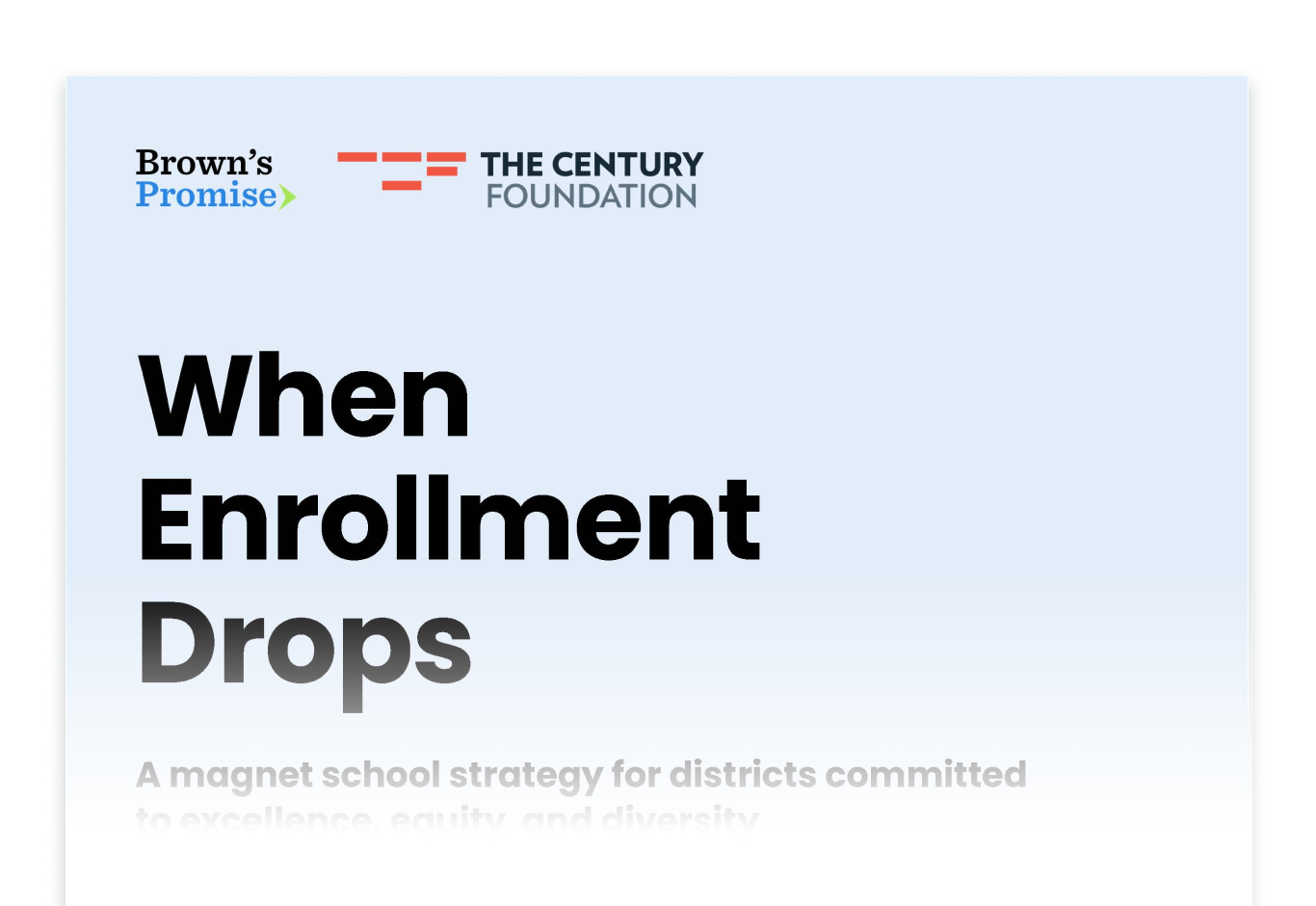School districts across the country are currently facing the reality of declining enrollment and wrestling with decisions about school closures.
Brown’s Promise and The Century Foundation have partnered to create a guide encouraging districts to consider whole-school magnet programs as a proactive, equity-centered strategy for addressing declining public school enrollment. The guide, “When Enrollment Drops: A Magnet School Strategy for Districts Committed to Excellence, Equity, and Diversity,” is a practical resource for education leaders and advocates who value diversity and equity seeking solutions to declining enrollment in their districts.
Read the introduction below or the full report here.

___________________
Introduction
Many states and districts across the country are facing declining student enrollment, and with it, declining per pupil funding from state and federal revenue sources.
They are simultaneously experiencing the “fiscal cliff” that occurred when billions of dollars in federal Covid-relief funding ran out in 2024. This is a difficult time for those whose job it is to balance a school district’s budget.
Districts often turn to school consolidations/closures in times of financial stress. Often described as “consolidation” by district leaders, they are felt and described as “closures” by communities, educators, and students. While consolidation can increase access to resources
and opportunities otherwise not available to students in under-enrolled schools, they do not always save as much money as hoped, and the underlying school closures disproportionately hurt students of color (especially Black students) and students living in poverty.
This brief offers district leaders a different approach: protecting schools in high-poverty neighborhoods from closure and instead increasing enrollment by transforming them into innovative, theme-based, and diverse whole-school magnet programs that serve all neighborhood students as well as attracting others from across the district.
To be clear, this is not a silver bullet or holistic strategy to address the multitude of challenges accompanying declining enrollment. For instance, districts cannot shift demographic declines or economic trends causing families to flee geographically; but they can work toward making district schools more appealing compared to private, parochial, or homeschooling options. Furthermore, magnet schools will be more helpful in some contexts than others. (For example, districts that already have a charter-heavy or lottery-based approach to operating public schools may not find this idea new or relevant.) But it is a concrete idea that could provide leaders in many traditional districts a real alternative to some of the most commonly used and problematic approaches.
Tags: school funding, high poverty schools, educational equity, school districts
When Enrollment Drops: A Magnet School Strategy for Districts Committed to Excellence, Equity, and Diversity
School districts across the country are currently facing the reality of declining enrollment and wrestling with decisions about school closures.
Brown’s Promise and The Century Foundation have partnered to create a guide encouraging districts to consider whole-school magnet programs as a proactive, equity-centered strategy for addressing declining public school enrollment. The guide, “When Enrollment Drops: A Magnet School Strategy for Districts Committed to Excellence, Equity, and Diversity,” is a practical resource for education leaders and advocates who value diversity and equity seeking solutions to declining enrollment in their districts.
Read the introduction below or the full report here.
___________________
Introduction
Many states and districts across the country are facing declining student enrollment, and with it, declining per pupil funding from state and federal revenue sources.
They are simultaneously experiencing the “fiscal cliff” that occurred when billions of dollars in federal Covid-relief funding ran out in 2024. This is a difficult time for those whose job it is to balance a school district’s budget.
Districts often turn to school consolidations/closures in times of financial stress. Often described as “consolidation” by district leaders, they are felt and described as “closures” by communities, educators, and students. While consolidation can increase access to resources
and opportunities otherwise not available to students in under-enrolled schools, they do not always save as much money as hoped, and the underlying school closures disproportionately hurt students of color (especially Black students) and students living in poverty.
This brief offers district leaders a different approach: protecting schools in high-poverty neighborhoods from closure and instead increasing enrollment by transforming them into innovative, theme-based, and diverse whole-school magnet programs that serve all neighborhood students as well as attracting others from across the district.
To be clear, this is not a silver bullet or holistic strategy to address the multitude of challenges accompanying declining enrollment. For instance, districts cannot shift demographic declines or economic trends causing families to flee geographically; but they can work toward making district schools more appealing compared to private, parochial, or homeschooling options. Furthermore, magnet schools will be more helpful in some contexts than others. (For example, districts that already have a charter-heavy or lottery-based approach to operating public schools may not find this idea new or relevant.) But it is a concrete idea that could provide leaders in many traditional districts a real alternative to some of the most commonly used and problematic approaches.
Tags: school funding, high poverty schools, educational equity, school districts